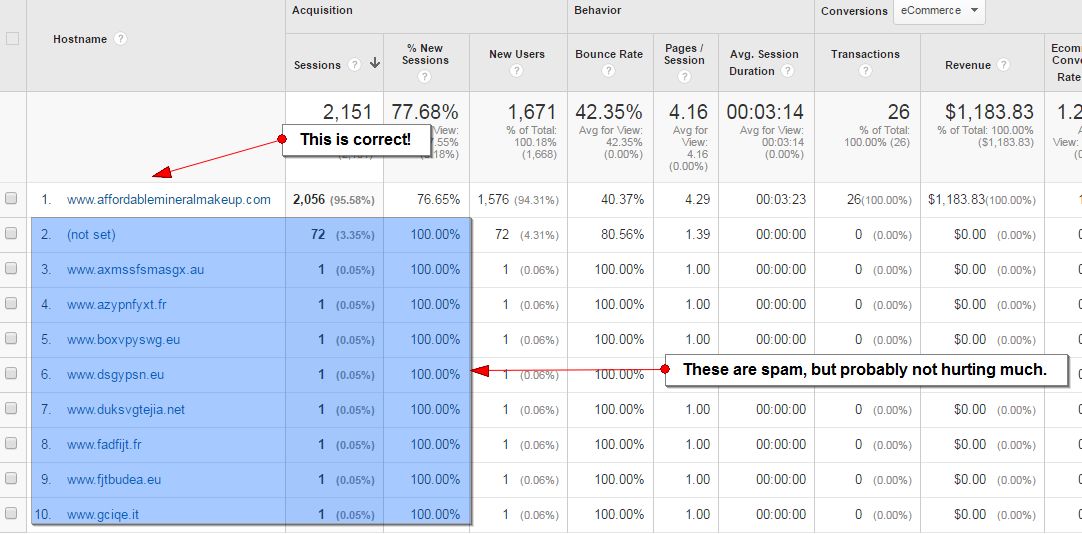Overview
Google Analytics, among other uses, is actually useful in testing, well, Google Analytics. In this lesson, we are going to review a few great reports which help us figure out whether Google Analytics is correctly installed on a specific web property.
Hostname Report
The hostname report helps us understand the specific hostnames (domains) which are firing our Google Analytics code. In this report, we can see all of the domains which are firing the analytics.js code for the Google Analytics property at-hand. In some cases, clients or previous website managers are using the same code for multiple websites making it difficult to get good reporting on any specific property. What we want to look for:
- Is the domain that we intend appearing in this report?
- Are there other domains appearing which we don’t want to track?

In the above screenshot, you can see that our correct hostname is firing, as are a number of spammy hostnames. This is actually a common form of analytics spam meant to trick you into visiting spammy websites. Typically, these can be ignored if the volume of traffic to these is low (and probably having minimal impact on metrics).
Referrals and Self Referrals
The referrals report is meant to report on websites which send traffic to our website. In some cases, we see that our website is listed within this report. When this happens, we know that there is an implementation or configuration issue which needs to be resolved. What to look for:
- Your root domain listed in this report
- A subdomain of yours listed in this report
- Another website which you own and that is part of the user flow listed in this report.

When we find domains listed here which shouldn’t be, we need to make modifications to either the Google Analytics code or the account itself. Either way, recognizing the problem is the primary goal to kick-off the process of researching why it’s happening.
Checking Goals and Ecommerce Conversions
When we set up goal and ecommerce tracking, things get a bit more complicated. We need to ensure a few things.
- Conversions are firing at the right time.
- The source of conversions is correct.
The Right Time
First, let’s talk about conversions firing at the right time. When setting a goal, we need to make sure it reflects an action and that we understand what that action is. For example, if we want to track a conversion which occurs each time our contact form is completed, we need to make sure that the goal itself is set up to only fire when a form is submitted. Usually, this means tracking each time a form submission confirmation appears. To test this, we can use the Goal URLs report to make sure that our goal is only firing on our confirmation page.

Depending on how your goals are configured, you may need to look at other reports to make sure that goals are not firing when they should not be. Another simple solution is choose a time period (say, 1 week) and make sure that the goals tracked in GA match those that actually occurred (number of new leads you got).
Goal and Transaction Source
Source tracking is probably the most important reason to track goals and ecommerce conversions. When checking a Google Analytics implementation, we want to check to see that the source of each lead is correctly attributed. In cases where GA code is missing or sub-domain/cross-domain tracking is not setup correctly, we often see sources out of whack. What to look for:
- A disproportionate number of conversions as self referrals (which should be none), direct, and from 3rd party sources like Paypal.
- No conversion data or inaccurate conversion data.

When we see either of the above, they raise flags to perform a deeper analysis as to why the source isn’t coming across correctly. Commonly, issues such as:
- Using Paypal (or another offsite payment processor) for payments but not setting paypal as a “referral exclusion” in the property settings.
- Incorrect sub-domain and cross-domain configuration
At the end of the day, a simple comparison of Google Analytics data to Offline Data (orders received, new contact forms emailed, etc.) is a great way to spot check that conversions are being tracked correctly. The importance of correctly installing Google Analytics cannot be overstated. It’s worse to look at bad data than to look at no data at all as decisions can be impacted and lead us astray. Our decision to double the budget on a campaign or cut it in half is almost always driven by metrics which we “trust” to be true.
The above reports are 2 simple reports which can help us resolve this big issue. When we find that our website does not pass one of these tests, we want to escalate the issue to the programming team to resolve issues related to these issues.


Leave A Comment